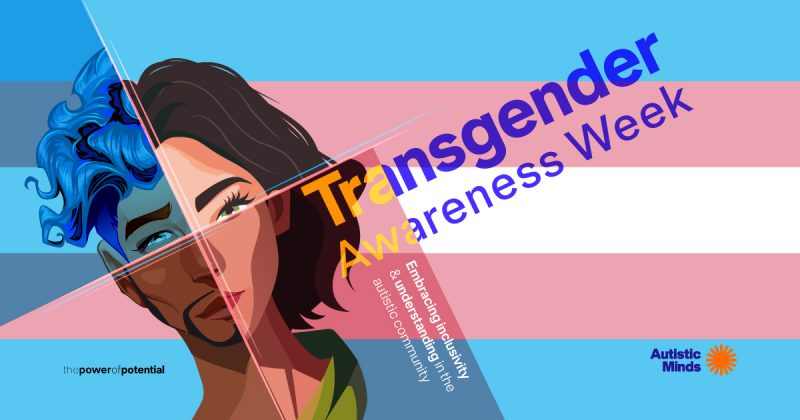Supporting Transgender autistic people: Practical tips for allies

Transgender Awareness Week is a time to uplift and support transgender individuals, but it’s also an opportunity to recognise the unique experiences of transgender people within the autism community. Transgender autistic people face distinct challenges at the intersection of gender identity and neurodiversity, from navigating healthcare systems to sensory sensitivities. Allies, including family members, friends, and caregivers, play an essential role in providing meaningful support that respects both their gender and neurodiverse identities.
Here are some practical tips on how to be a supportive ally to transgender autistic people.
1. Understand and respect their identity
Respecting the gender identity of a transgender autistic person starts with actively listening and understanding how they express and describe their gender. For autistic individuals, communication might differ from neurotypical expressions of gender, so it’s crucial to be open to their self-description. Ask about their pronouns, affirmed name, and how they wish to be identified without making assumptions based on outward gender expression. Remember that some autistic people might be less inclined to follow social conventions about gender presentation, which doesn’t make their gender identity any less valid.
Misunderstanding or questioning an autistic person’s self-identification can be harmful, particularly when dismissive comments suggest they can’t fully comprehend their gender due to autism. By validating their identity without imposing norms or expectations, allies can create a supportive environment where transgender autistic individuals feel genuinely accepted.
2. Embrace their sensory needs in gender expression
Autistic people often have specific sensory sensitivities, which can impact how they express gender. Clothing, hairstyles, and accessories traditionally associated with certain genders might be uncomfortable due to textures, tightness, or other sensory triggers. For instance, binders (used to flatten the chest) might feel restrictive or overwhelming for an autistic transmasculine person, while makeup and jewellery might cause discomfort for an autistic transfeminine person.
To help navigate these challenges, encourage experimentation with gender expression that aligns with their sensory needs. This might mean finding gender-neutral clothing that doesn’t irritate the skin, or exploring softer, more breathable fabrics that allow them to express femininity or masculinity comfortably. Importantly, remind them that there’s no “right” way to express their gender, their comfort and sense of authenticity matter most.
3. Practice patient, open communication
Autistic individuals may communicate differently, so it’s essential to approach conversations about gender with patience and openness. Some might struggle with social cues or find it challenging to articulate complex feelings. For others, discussing gender and identity may require time and careful consideration. Giving them space to process and communicate in their own time, without pressure, can make a significant difference in helping them feel understood and supported.
Using clear, straightforward language in conversations can also aid communication. Avoid ambiguous statements, and instead, ask direct but open-ended questions such as, “what would help you feel comfortable today?” Or “is there a specific way you’d like me to support you?” By respecting their communication style and allowing space for self-expression, you can foster a trusting relationship that honours their autonomy.
4. Advocate in healthcare settings
Navigating healthcare can be challenging for transgender autistic people, especially when they encounter professionals who may not be familiar with the intersection of gender identity and neurodiversity. Healthcare providers may unintentionally misinterpret autism-related behaviours as indecisiveness about gender identity, leading to delays in necessary support or treatment.
As an ally, you can help by advocating for their needs and facilitating clear communication in medical settings. Before appointments, work together to create a list of questions, needs, or goals to make the encounter smoother. Many autistic individuals benefit from knowing what to expect, so discussing the steps of an appointment or treatment plan in advance can also ease anxiety. If they are comfortable with it, accompanying them to appointments and advocating alongside them can make a world of difference.
5. Connect them with inclusive communities
Isolation can be particularly difficult for transgender autistic people, as they may feel misunderstood by both the broader lgbtq+ community and the autism community. Helping them find inclusive spaces, online or in-person, where they can connect with other transgender autistic people can be profoundly affirming.
Look for communities and support groups that cater to both transgender and neurodiverse identities. These spaces offer unique peer support, where they can meet people with shared experiences and find resources that speak directly to their needs. Many organisations are working to bridge the gap, such as specialised autism centres with lgbtq+ programming or social media groups that welcome neurodiverse lgbtq+ members.
6. Respect their need for routine and predictability
Many autistic people find comfort in routine, and disruptions can cause significant stress. If a transgender autistic person in your life is navigating a major life transition, such as coming out or socially transitioning, the disruption to their routines may feel overwhelming. Small adjustments, like setting a regular time for pronoun practice or gradually integrating new clothing into their wardrobe, can provide a sense of predictability and control.
Supporting them through these changes with empathy and understanding, while maintaining elements of their daily routines, helps ease the transition process. For example, if they’re starting to wear gender-affirming clothes, begin with options that fit into their established wardrobe rather than overhauling it all at once.
Final thoughts
Supporting transgender autistic people requires respect, patience, and a willingness to understand their unique needs at the intersection of gender and neurodiversity. By offering affirming support that respects their sensory preferences, communication style, and need for routine, allies can create a positive and inclusive environment where transgender autistic individuals can thrive. Embracing these small but meaningful steps allows allies to be a vital part of their journey toward self-acceptance and well-being.





 01443 844764
01443 844764